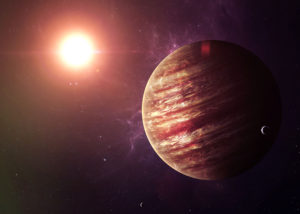The largest planet in our Solar System dominates spring skies
The largest planet in our Solar System dominates spring skies.
By Steve Kates
The night skies of Arizona are above for your viewing and enjoyment. We’re lucky to be located in this most amazing location, where the dark of the night sky is just a short drive away.
April offers us some amazing treats in the sky. This is the month of Jupiter, the king of the planets. Jupiter is the largest of the planets in our Solar System and this year Jupiter will be some 414,780,000 miles from Earth, in the constellation of Virgo.
As you were going about your business earlier in the year, Jupiter and the Earth were quietly moving closer, day by day. Jupiter will come to opposition on the night of April 7 and be the dominant planet in the evening sky. It will rise at sunset in the southeastern sky and glide across the sky and be visible from sunset to sunrise.
Of all the planets that you can see here in Arizona, Jupiter puts on one of the best shows via binoculars and telescopes. The fact that the planet is rather large in our sky helps us to see a large amount of detail in a small scope. With a decent size and power of binoculars, you may even get to see the four main moons of Jupiter––something that Galileo did back on Jan. 7, 1610, with his crude telescope. Adding to the excitement of Jupiter’s proximity in April, the Juno spacecraft is now sending back some amazing images of this giant planet.
Closer to home, the moon begins April as a waxing crescent and moves on to first quarter on the 3rd. Get set for the next full moon on April 11, it’ll be a full pink
moon, also known as a full egg moon. The moon is technically full on April 10 at 11:08 p.m. MST for us here in Arizona. The moon then moves on to last quarter on April 19 and back to it’s new phase on the 26th.
For planets, April is rich in offerings. Jupiter, as mentioned above, headlines the all star cast, followed by Mercury, low in the western skies at sunset by the 1st.
The morning planets of April are Saturn, low in the southeast at sunrise, as well as Venus in the east ahead of the dawn. Venus will reach its greatest brilliancy on the 29th. Venus is amazing, as it’s the most brilliant object in the sky. Don’t miss it.
The annual Lyrid meteor shower peaks on the morning of April 22, high in the northeastern sky before dawn. The light of the full moon will spoil the show and all but for the brightest of Lyrids will be visible.
The month of May is a great time to view the wonders of the spring Milky Way. As May progresses, the Milky Way hugs the horizon from east to north and west at 9 p.m. local time, but runs due north and south just before sunrise. Pick the week of May 21 to view the wonders of the Milky Way in a dark location. Use a pair of binoculars for the best view.
First quarter moon occurs on May 2, with another meteor shower on the morning of the 5th. Look low in the southeastern sky after midnight for the annual Eta Aquariid meteor shower. All of the debris from this shower is brought to you courtesy of Halley’s Comet.
The full moon of May is the full flower moon and it occurs on the 10th at 3:42 p.m. MST for us in Arizona. A most magical moon, it rises in the southeast at sunset. Last quarter moon is on the 18th, with a new moon on the 25th.
Jupiter is quite the planet in May, holding its own in the east at sunset. Look for Saturn and Venus in the early morning sky. Meanwhile, Mercury shines bright and ahead of the Sun on the 17th in the northeastern sky before dawn.
Jupiter
Jupiter’s gravity is so strong that a rocket would have to go an unthinkable 135,000 mph to lift off the planet’s surface.
The temperature near the planet’s core may be about 43,000 degrees Fahrenheit—hotter than the surface of the sun.
If it was 80 times more massive, Jupiter would have become a star instead of a planet.
As a gas giant, Jupiter is mostly made of hydrogen and helium, so its surface isn’t solid.
The Milky Way
The Milky Way contains over 200 billion stars.
There is a black hole at its center.
The Milky Way is part of a larger cluster of galaxies known as the Virgo Supercluster.
The Milky way is rich in gas and dust.
Related posts
Leave a Comment
You must be logged in to post a comment.







